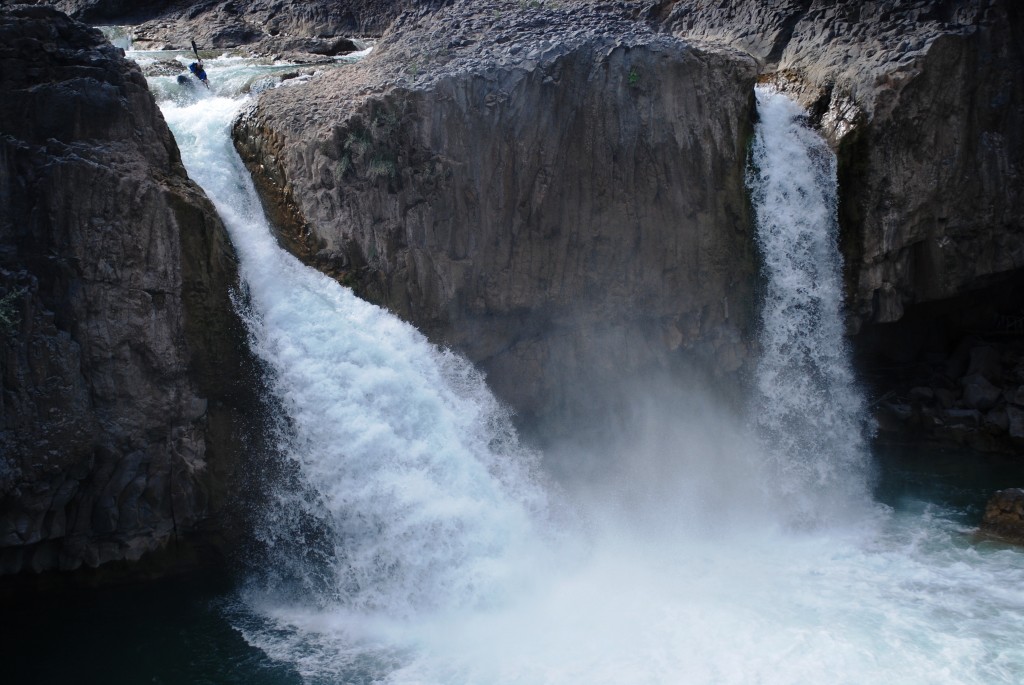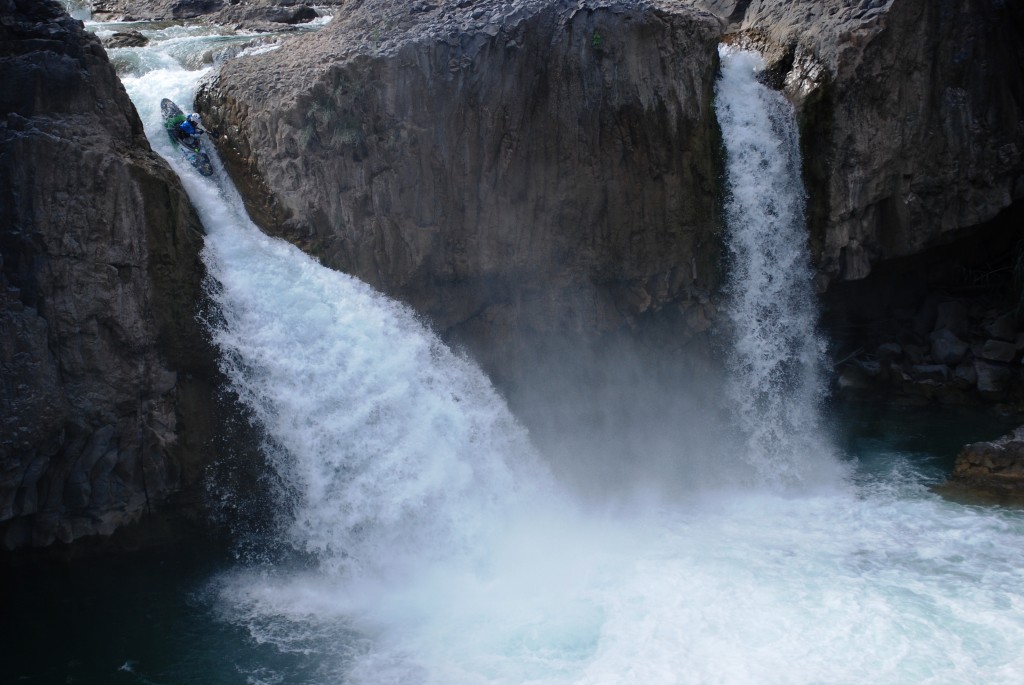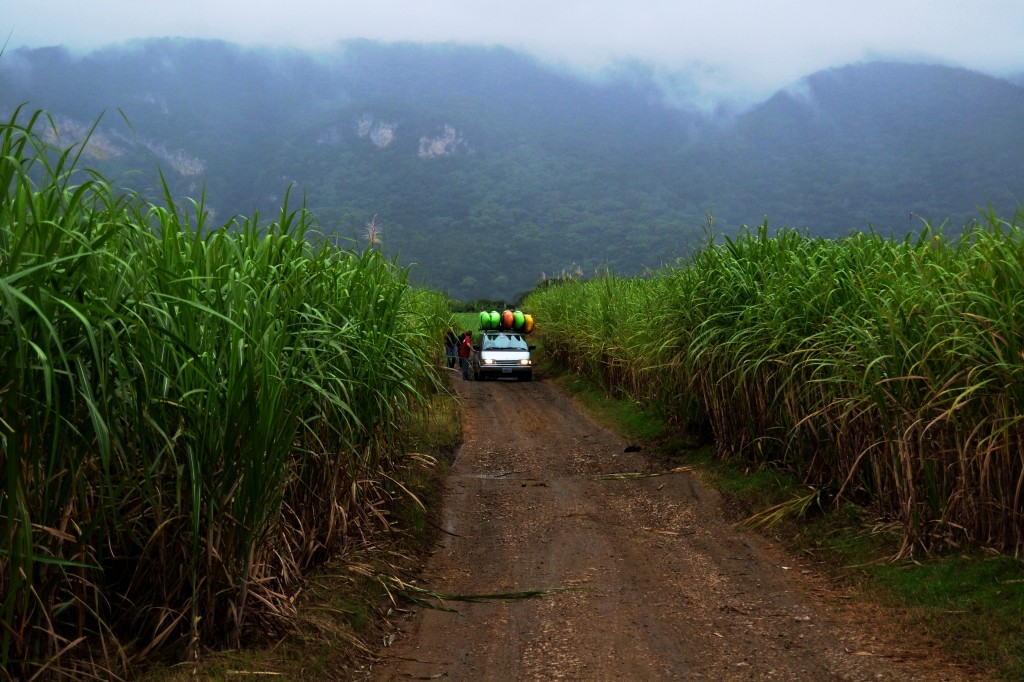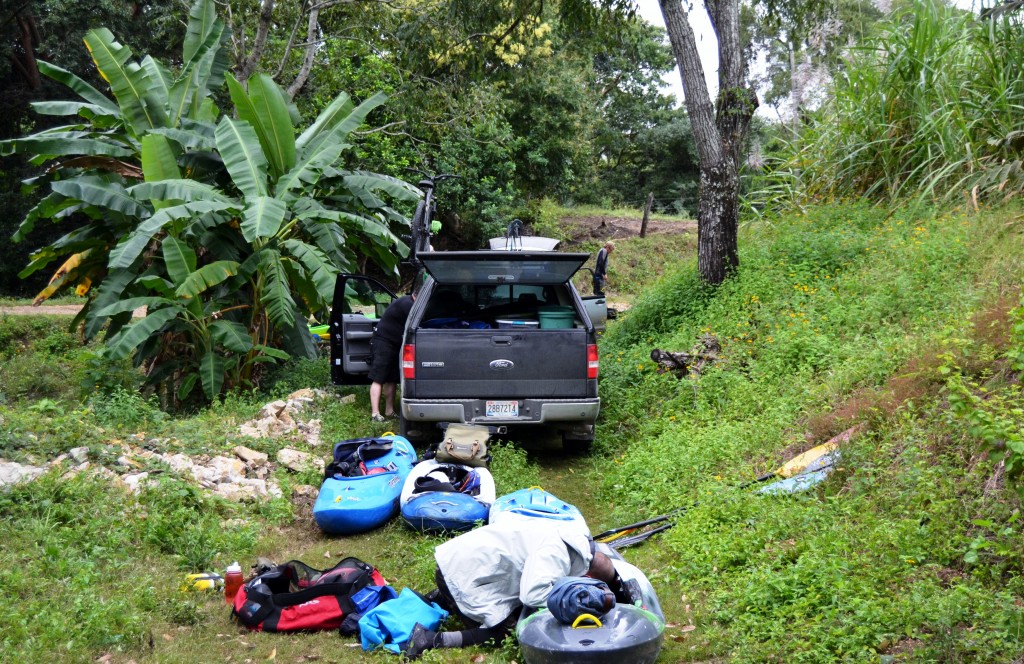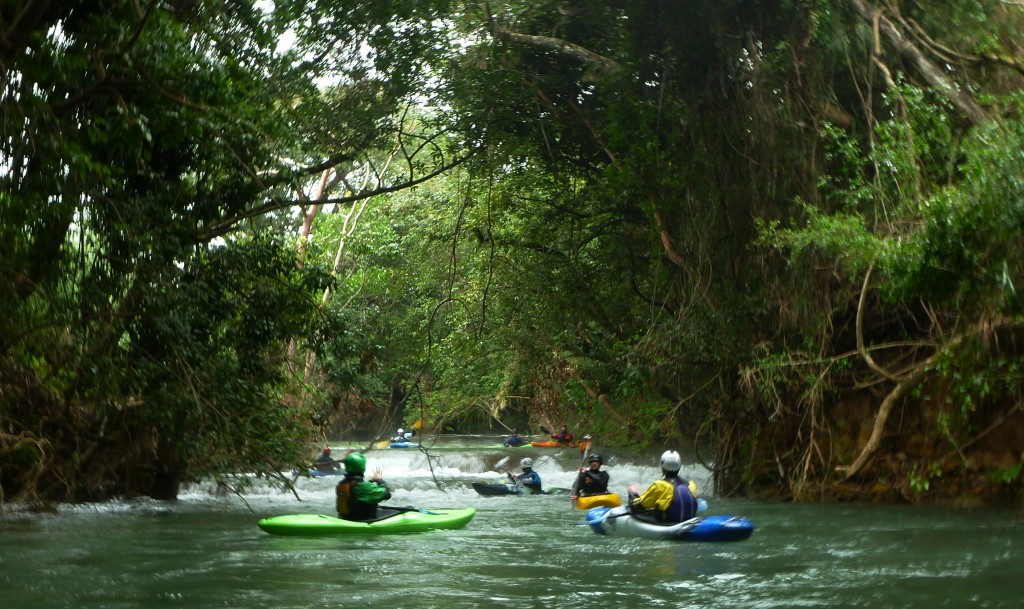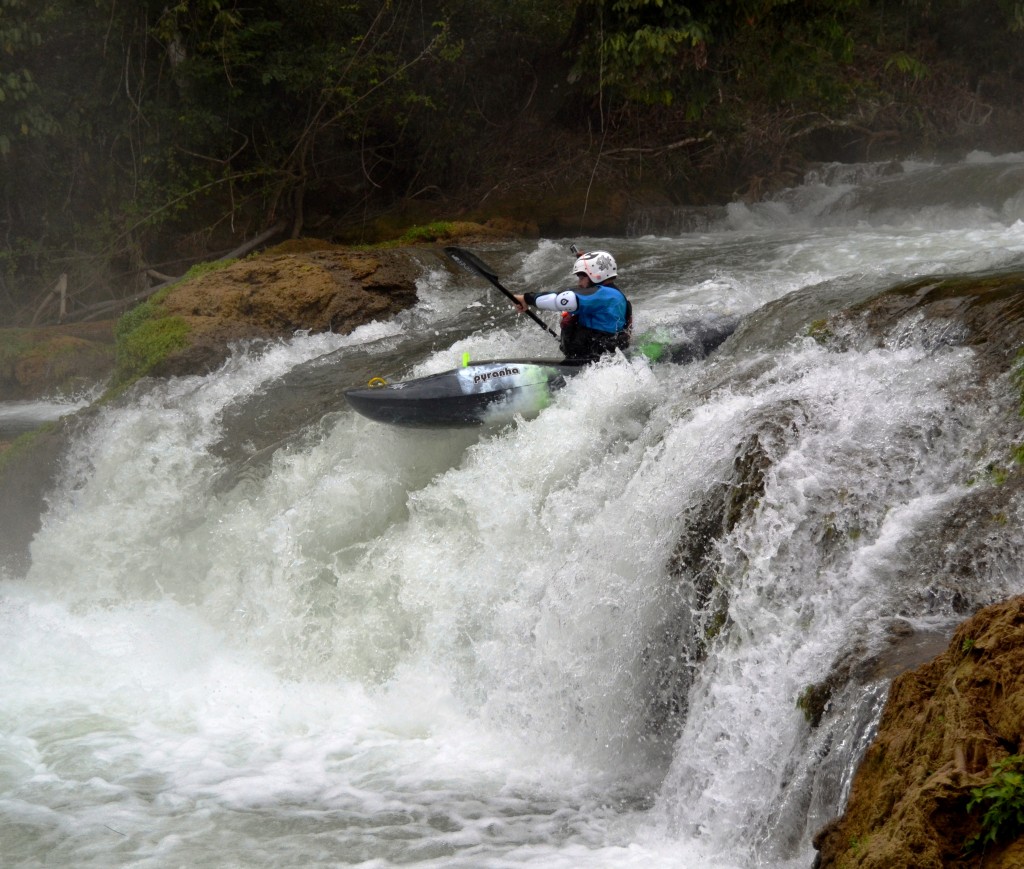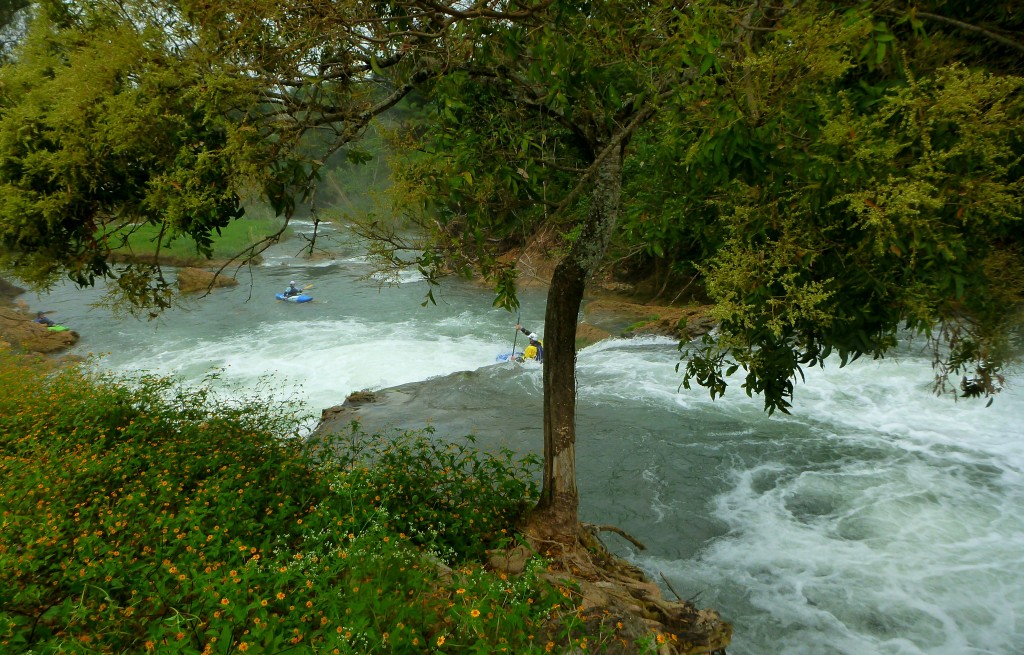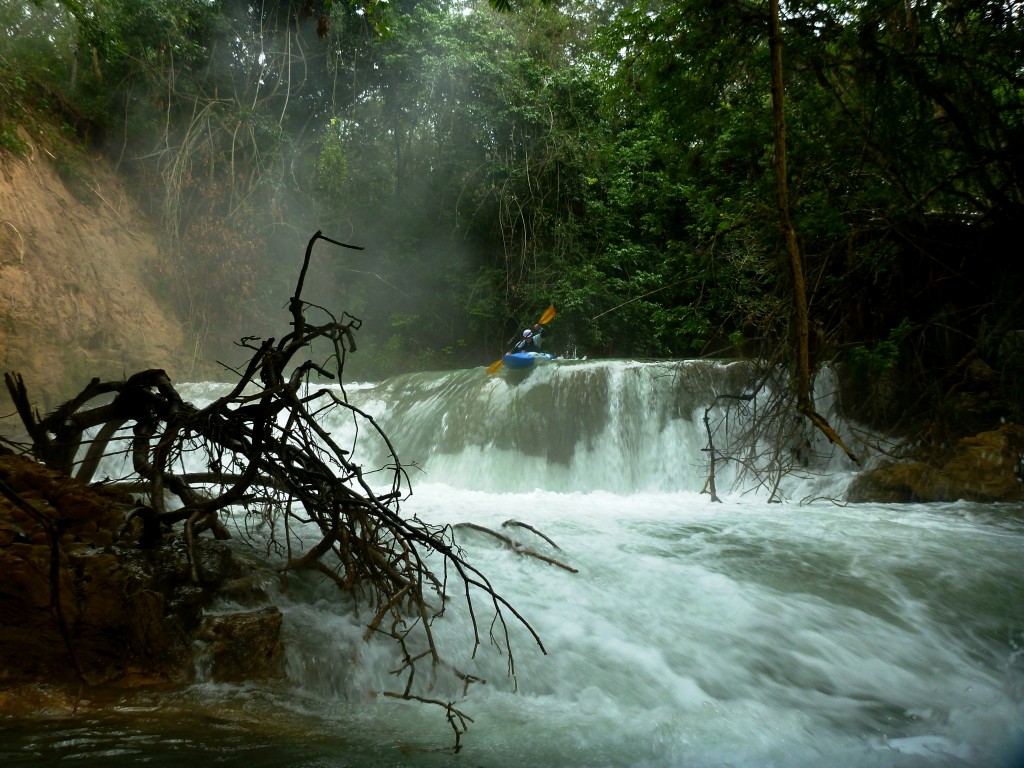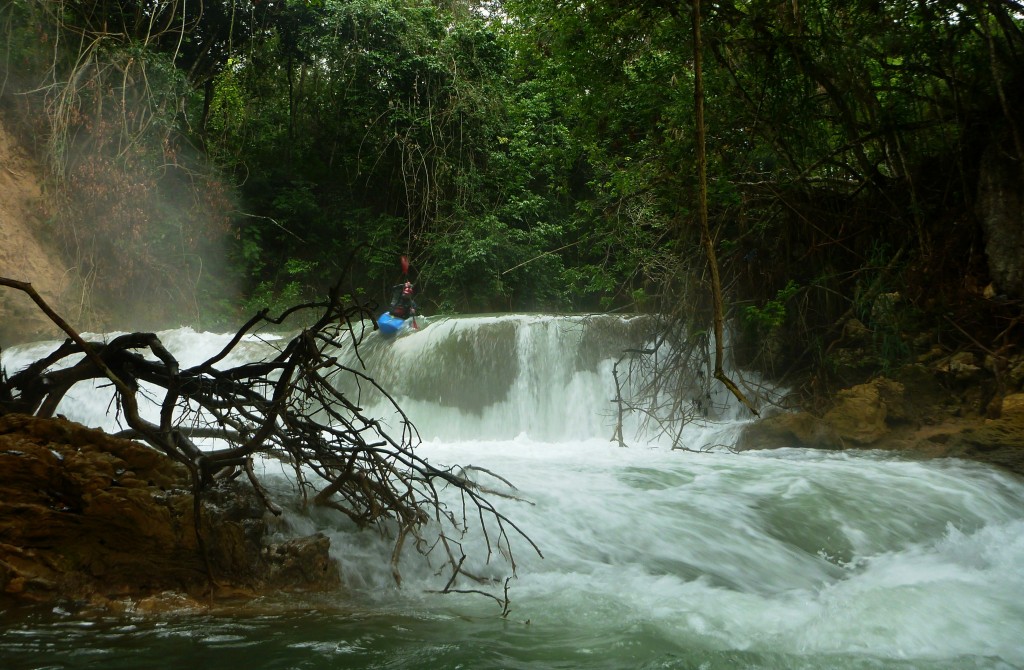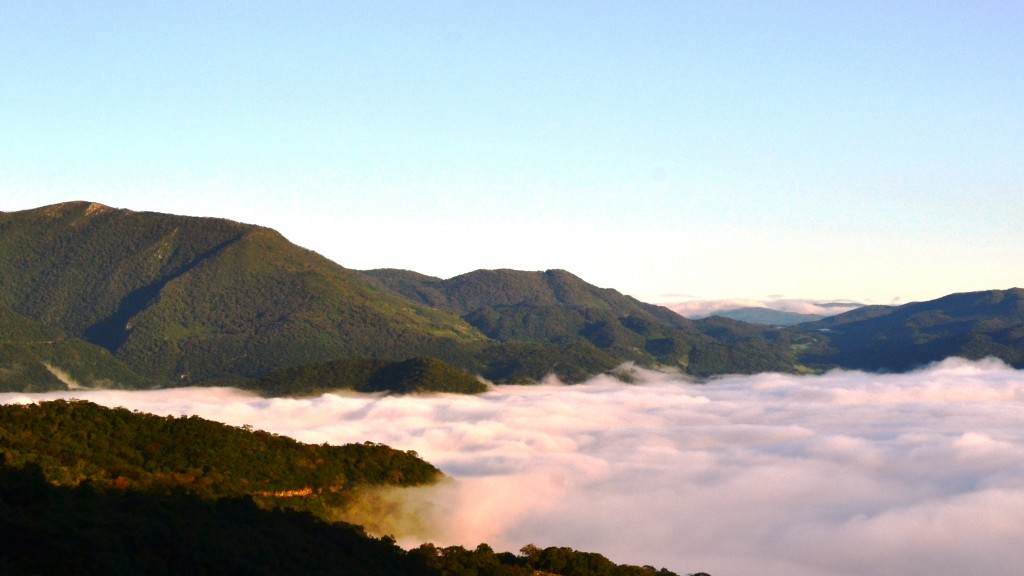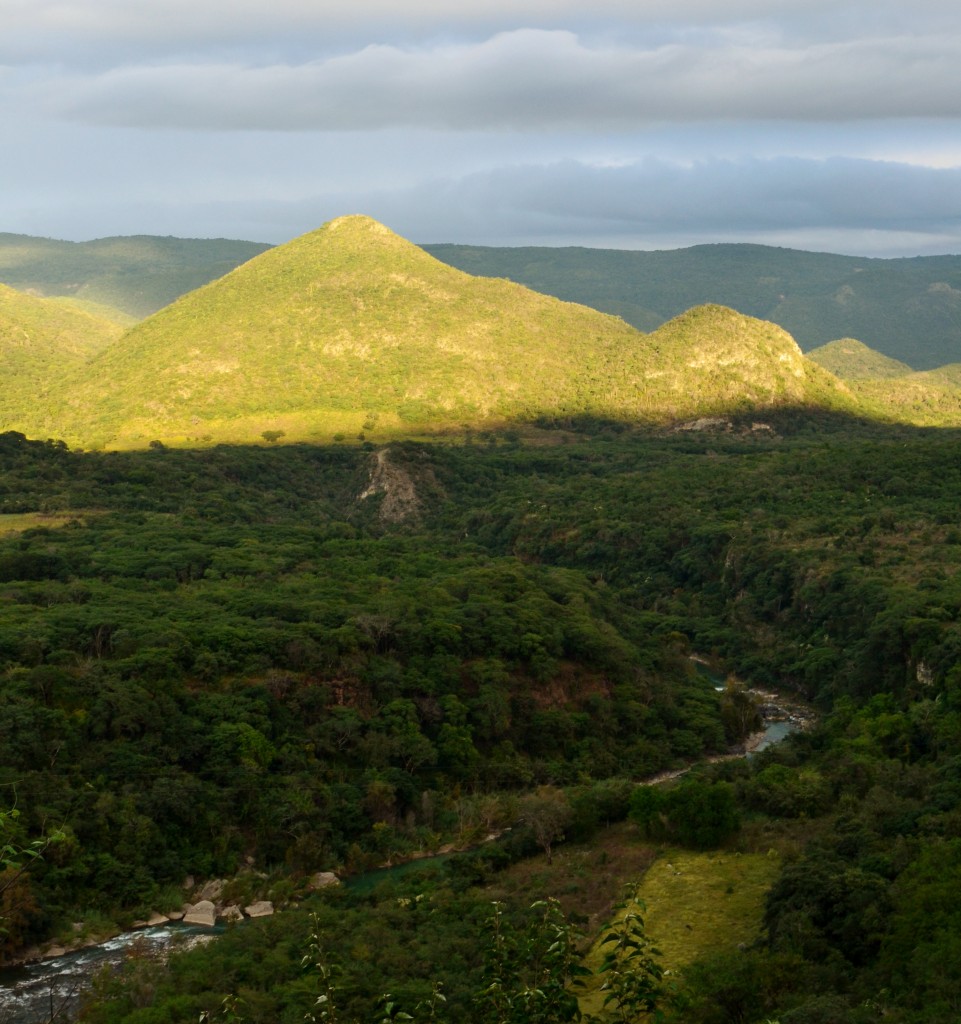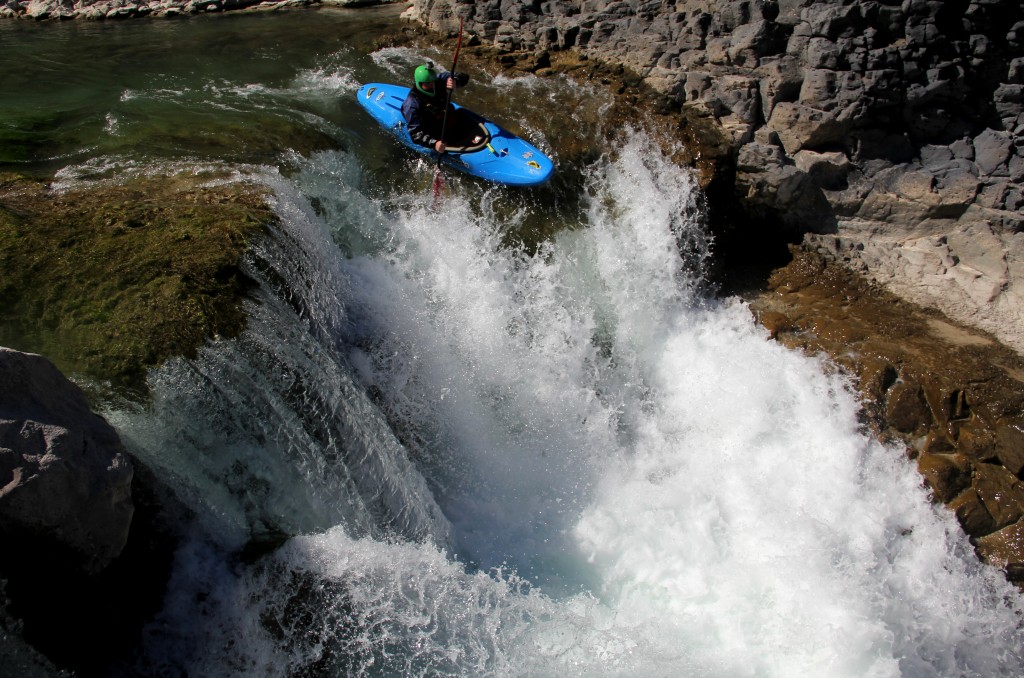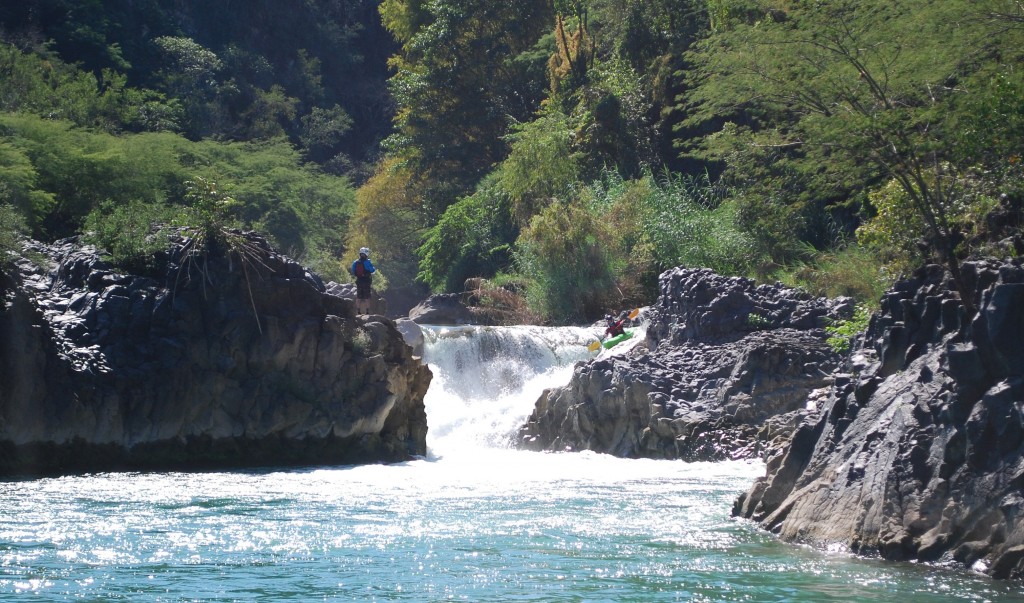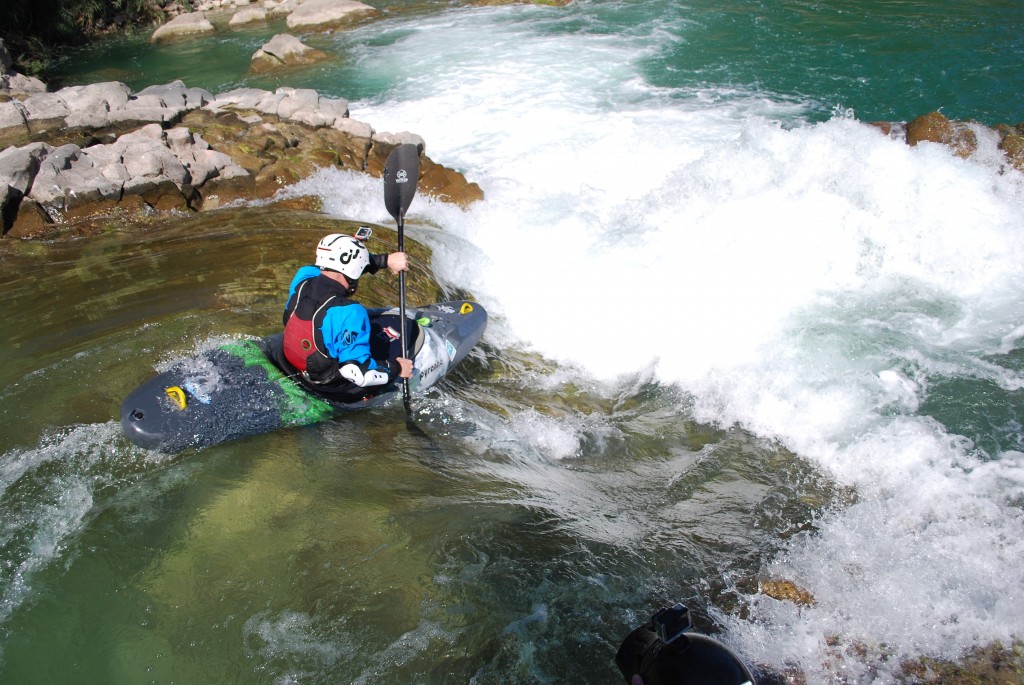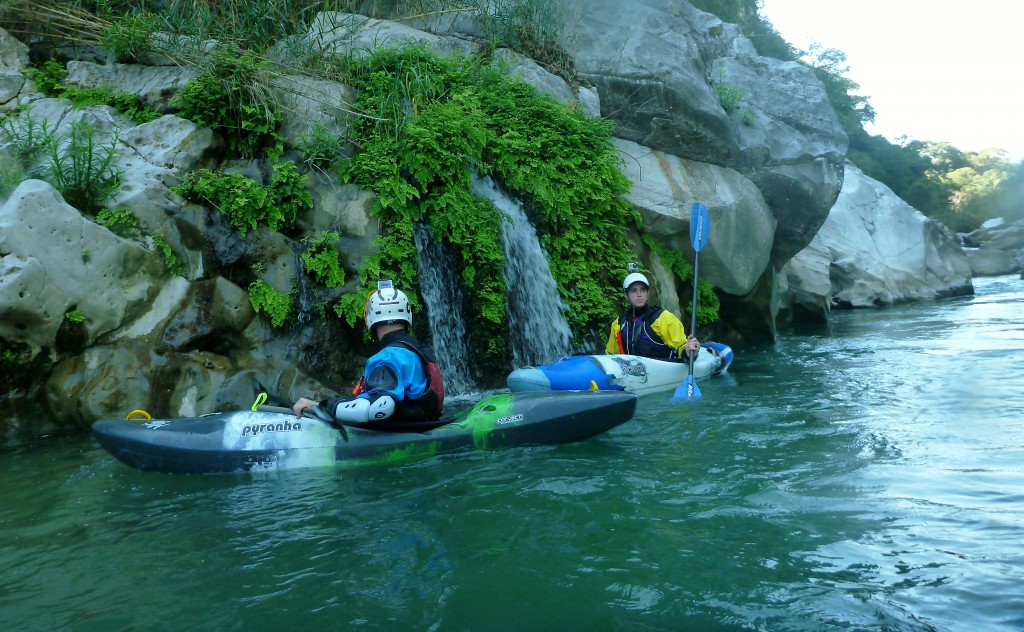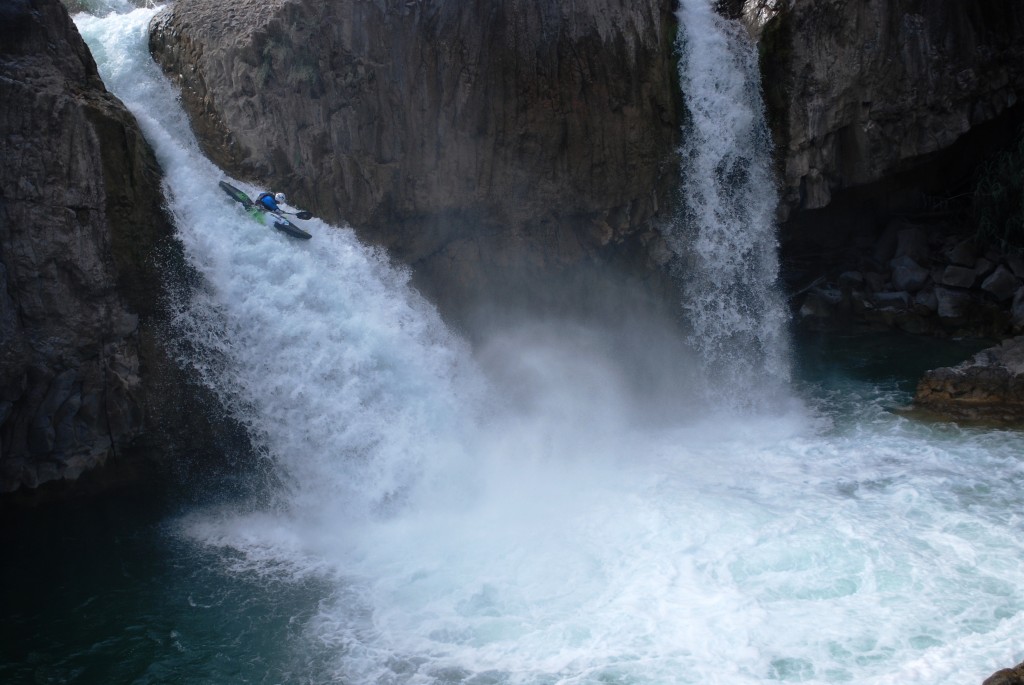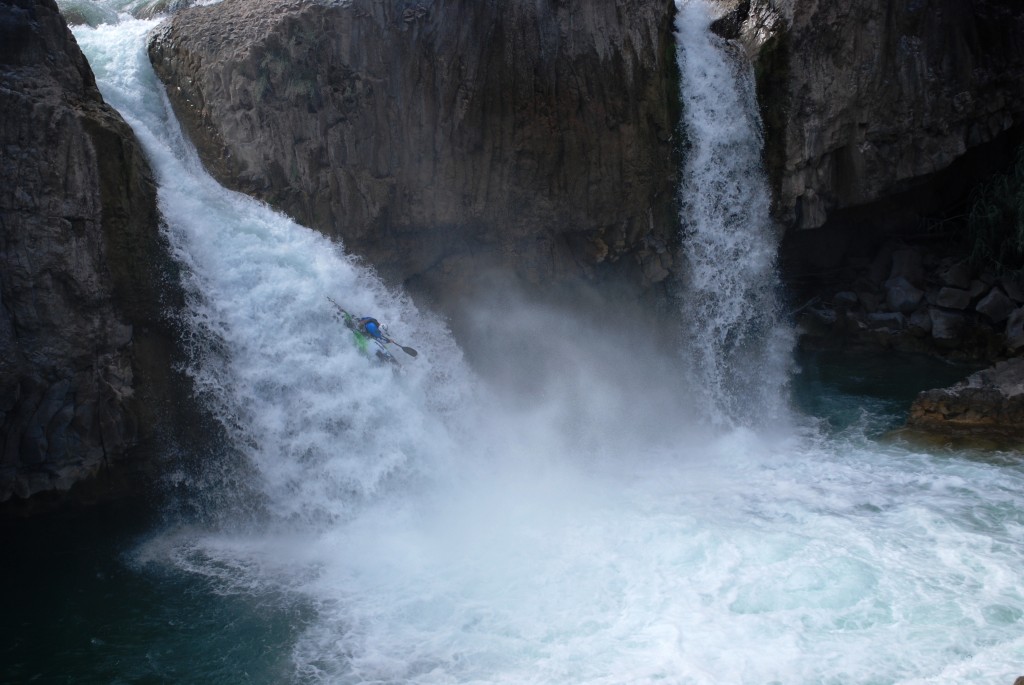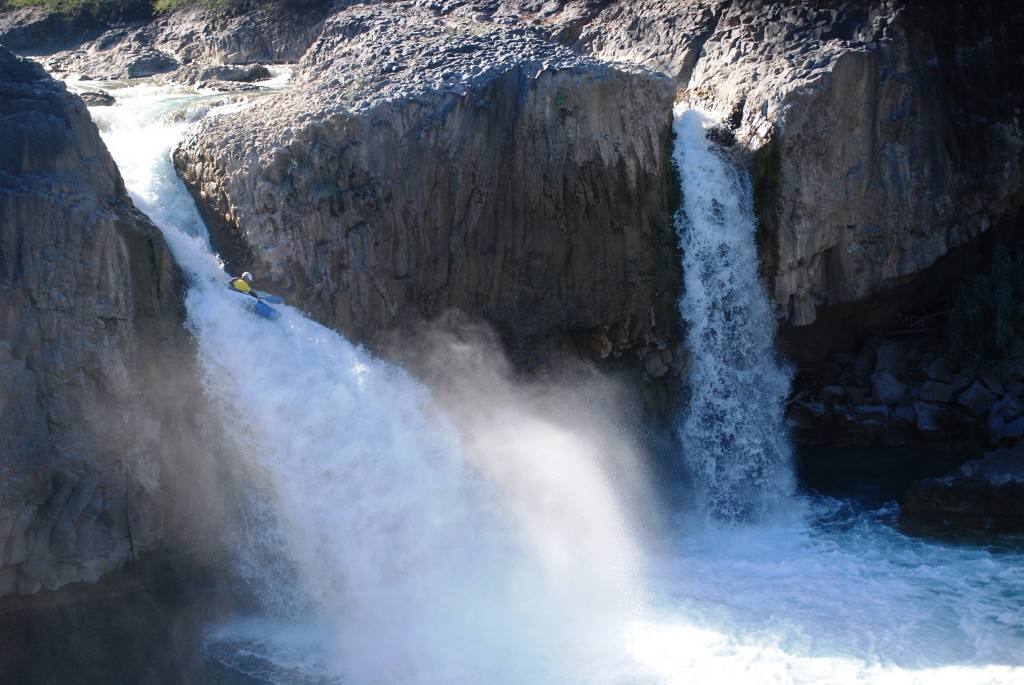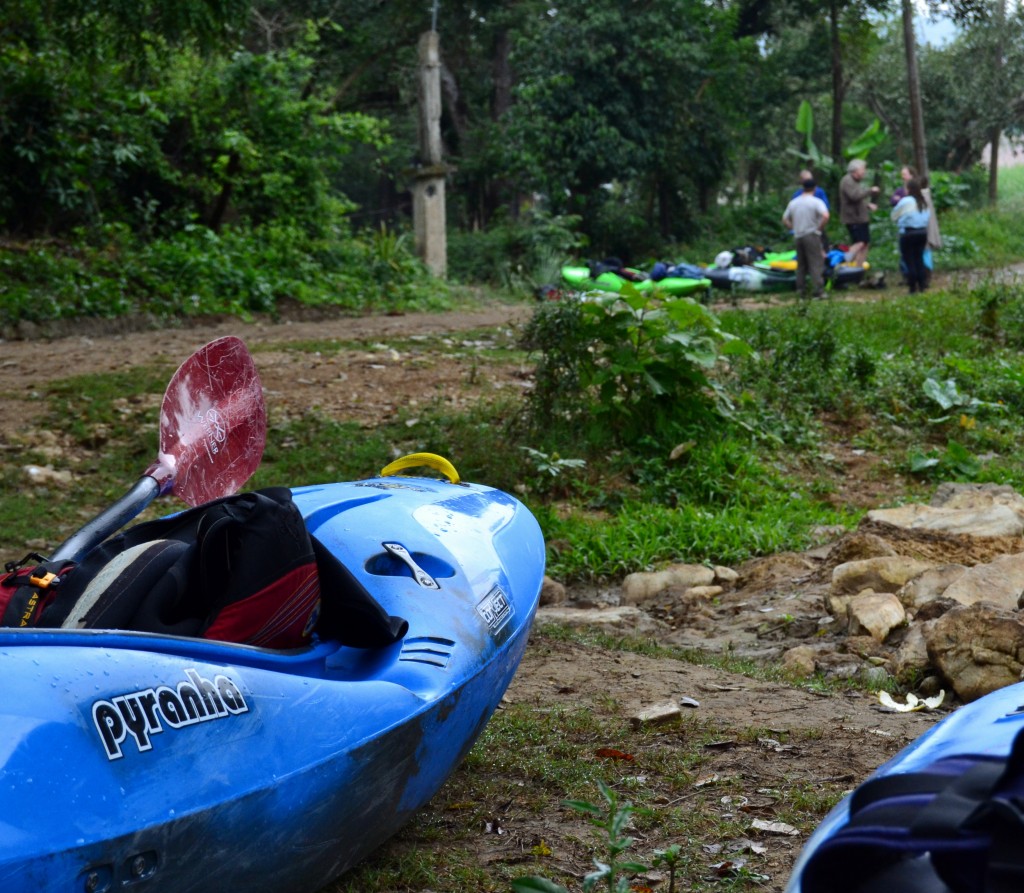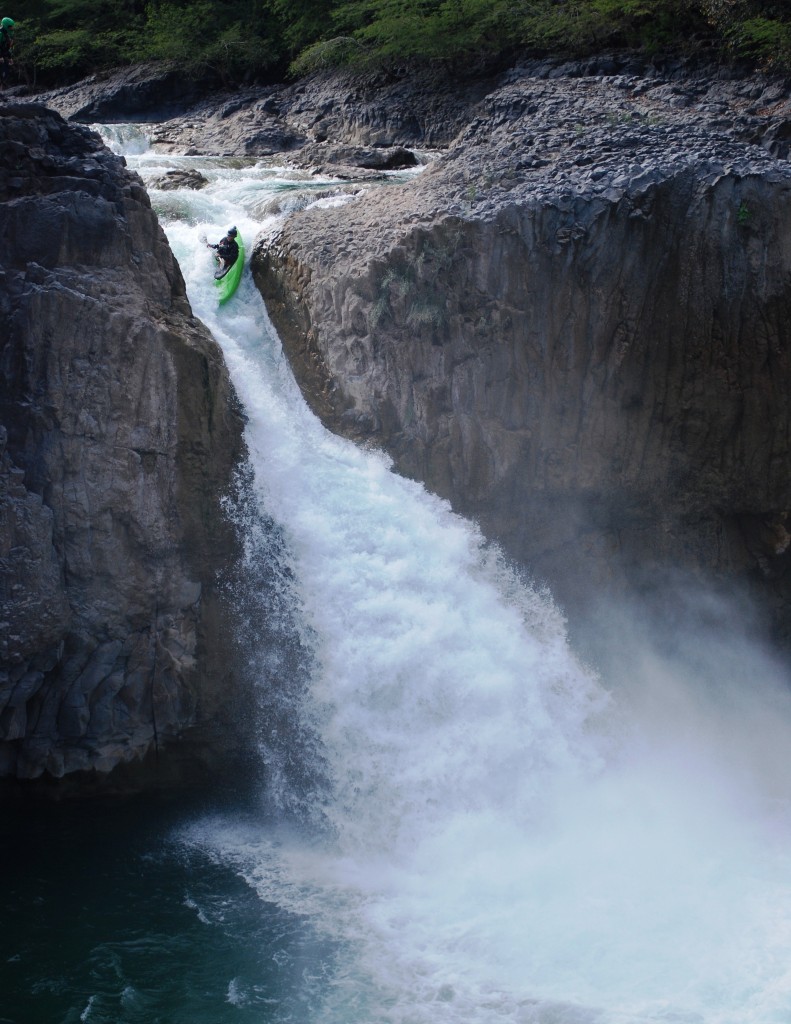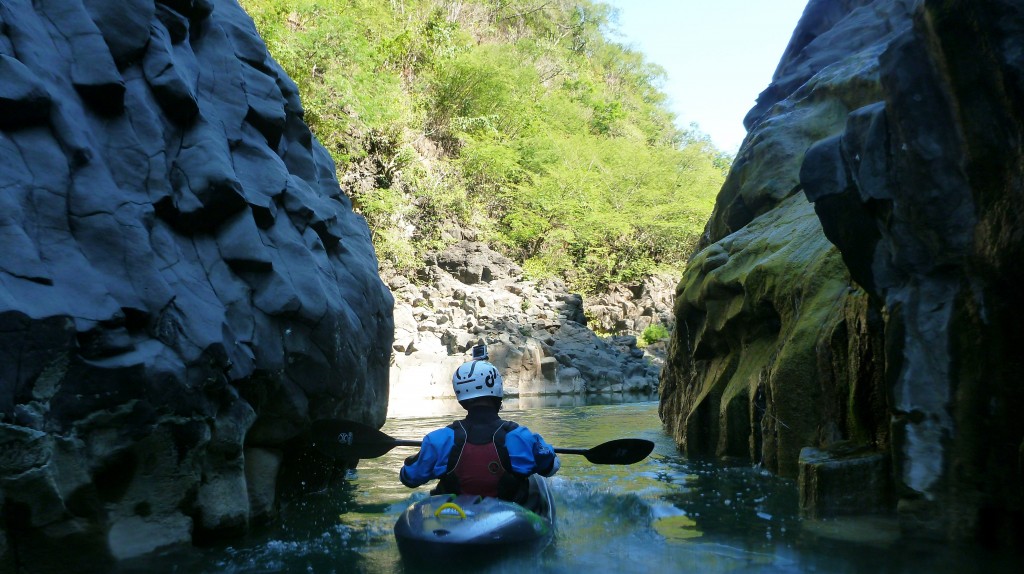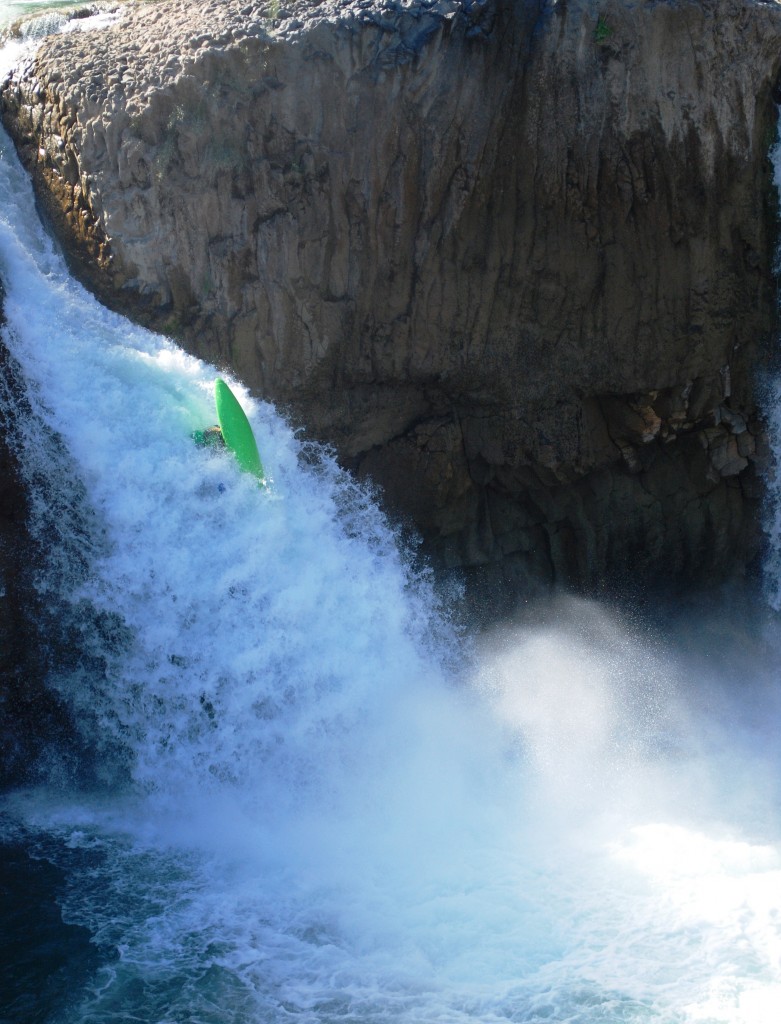Below: Matt Beauchamp running Puerta del Salto in the second canyon of the Rio Verde, photos by Adam Goshorn
Just after dark on the day we ran the Rio Minas Viajas (see Mexico 2013 Part I HERE), we were driving down the narrow driveway into the Aldea Huesteca campground when we met a van going the opposite way. There were no boats on the roof, so at first I wondered if it might be the campground employees leaving for the night, but then the silhouette of kayak stackers caught my eye. Windows rolled down on both vehicles and someone inside the van called out from the darkness, “Is Adam Goshorn in there with you guys?” The voice was Brett Barton. Our mutual friend Matt Taylor had told both of us to be on the lookout for each other since we would be in the same regions of Mexico around the same time. Brett and I had briefly corresponded online, but hadn’t made any firm plans to meet up due to both of us wanting to stay flexible and being hesitant to commit to a specific timeline. However, here we were on the evening of our second night in Mexico already running into each other and staying at the same campground. The frequentness of such encounters with friends and acquaintances from the paddling community while far from home continues to astonish me… despite it happening too many times to count over the last decade.
Below: Team Previa deep in the cane in route to the Rio Frio, photo by Evan Alfano
Below: Unloading at the put-in for the Rio Frio, photo by Evan Alfano
Brett and Joni Randall had driven Joni’s 1997 Toyota Previa from WashingtonState to Colorado, where they picked up Jake Perizzolo and kept driving all the way to San Luis Potosi, Mexico. Team Previa (as we dubbed them, soon thereafter) had run the El Salto section of the Rio Valles on the day we had paddled the Cascadas Micos section. On the day we met them on our way home from dinner after paddling the Rio Minas Viejas, they had just paddled the Cascadas Micos and were headed into town to get a few beers. Later that night, after they returned to the campground, it was decided that all of us would head to the Rio Frio together the following morning. Team Previa had run the Cascadas Micos with another pair of paddlers who had arrived at Aldea Huesteca while we were out paddling the Rio Minas Viejas. They also asked to join us for the Rio Frio and we agreed, bringing our combined crew for the following day up to nine.
Below: Early ledges on the Rio Frio, photos by Brett Barton
The Rio Frio is one of the three main tributaries that combine to form the Rio Gallinas about an hour’s drive west of our campsite at the Cascadas Micos. The shuttle for the Rio Frio is only a few miles, but the road is quite rough so having two vehicles saved us from what would have been a somewhat miserable bike shuttle, had we gone there on our own. Our group of four was riding in my truck while the other five piled into Joni’s Previa. The closer you get to the put-in for the Rio Frio the worse the road conditions become. The last quarter-mile is especially muddy and a few sections required everyone riding in the Previa to get out and walk to prevent it from bottoming out in the deep muddy ruts. Eventually, we arrived at the put-in, unloaded boats, and Jake and I retraced our route through the mud two more times to set shuttle.
Below: Matt Beauchamp on the first of the “new” rapids on the Rio Frio, photo by Evan Alfano
Below: Evan Alfano on the same, photo by Brett Barton
Leaving the put-in, the Rio Frio starts off slow with only the occasional small travertine ledge and a large down tree to negotiate. Locals picking oranges high on the left bank waved to us and then proceeded to toss oranges straight from the tree, into our outstretched hands. As we ran a few more ledges in the three-foot to four-foot range, I explained to the group what I remembered about the first of the slightly larger drops on the run. I was the only one who had paddled the Rio Frio before, so I was doing my best to remember what I could from my previous runs. However, without stopping to scout our whole group paddled into what I had described to them as an easy rapid-to-slide combo. What we found was something completely different, but luckily nothing dangerous. High water had blown out several travertine dams and dramatically changed the set of drops. For once, I can say that high water actually changed a river for the better! The “new” drop was a really fun, fast rapid that accelerated paddlers into a nice water-boof off an eight-foot ledge. It was so much fun that most of us walked back up to run it three or four times!
Below: Shannon Goshorn on the biggest of the drops on the Frio, photo by Brett Barton
Below: Adam Goshorn on the same, photo by Matt Beauchamp
The changes that took place at the first bigger rapid were an indicator of what we would encounter throughout the day. Many small travertine dams had been partially or completely broken. In one spot, a three-foot travertine dam had a vertical crack in it that swallowed most of the volume of the river, but was slightly too narrow for a kayak to pass. At the site of what has always been the biggest rapid on the Rio Frio, we found more dramatic changes. What had previously been a six-foot ledge into another four-foot ledge was now a ten-foot ledge with a sticky U-shaped hole. The high water had caused the second ledge to collapse… along with much of the hillside on the right! A few people tangled with the hole, but we completed the rest of run without incident and over dinner that night in Cd. Valles we made plans to paddle the second canyon of the Rio Verde the following day.
Below: Getting above the clouds on the drive over the mountains to the Rio Verde, photo by Evan Alfano
Below: View of the Rio Verde from the shuttle road, photo by Evan Alfano
We woke up early, ate a quick breakfast at camp, and were on the road by 7:00 AM. The drive over the mountains to the Rio Verde usually takes about three and a half hours, but a new toll road sped up our pace considerably, shaving almost an hour off the trip! We unloaded boats and left most of the crew on the side of the road where the hike down to the put-in begins. Shannon would be shuttling my truck for the day, but since she had never been there before, I wanted to show her where the take-out was located. So, Jake followed us in the Previa to park it at the take-out as well. An hour and a half of terrible roads later, Jake, Shannon, and I arrived back with the rest of the crew, geared up, and began the hike to the river.
Below: Adam Goshorn on the Rio Verde, Photo by Brett Barton
Below: Brett Barton on the same rapid as viewed from below, photo by Adam Goshorn
The second canyon of the Rio Verde (a.k.a. Middle Verde) is one of the best runs in the area when it has good water. After having found great water levels on the Cascadas Micos and Rio Frio, I was optimistic about our chances of having favorable water levels for the Rio Verde as well. However, the glimpses of the river I had seen from the shuttle road looked low, but then again I was far away and looking deep into a shaded valley, so I didn’t mention it to anyone as we geared up and hiked in. Not to mention that having driven almost three hours to get to the river and another hour and a half to run shuttle, I was planning to run the river regardless of level and I’m sure most of the others felt the same way. Upon reaching the sandy bank at the put-in, it was clear the water was low, but thankfully not unrunnablly low. There are still several well-channelized, fun, rapids and drops on the Middle Verde, even at low flow. The down side is that there are also some long sections of slow moving water, a portage, and quite a few shallow cobble-bar rapids in the wider sections of the river. As we made our way downstream I tried to push the pace of the group as much as I could. I knew the low water would slow us down and I was also anticipating the group spending a fair amount of time at the biggest drop on the run, a waterfall in the 35-40-foot range, known as Puerta del Salto.
Below: Matt Beauchamp on the Rio Verde, photo by Adam Goshorn
Below: Warm springs trickling into the Rio Verde, Photo by Bret Barton
We made pretty good time throughout the day and indeed we ended up spending almost an hour at Puerta del Salto. Everyone scouted for a while and then one by one each person made their decision to fire it up. I took pictures and video of everyone else and watched their lines off the drop and the mixed results. The low water was making the entrance especially tricky and almost everyone was checking the left wall at the lip and struggling to salvage their line for the rest of the way down. Eventually, I was the only one left at the top and opted for the throw-and-go off the cliff on river right. Once we were headed downstream again, pretty much everyone’s thoughts turned to making downstream progress as quickly as possible, not wanting to be out on the highway late at night. We hammered out the rest of the rapids and the flat water at the end, reuniting with Shannon and our vehicles around 4:30 PM. After winding our way back to the pavement at the put-in and eventually the highway, the new toll road once again whisked us over the mountains in record time and we were back in Cd. Valles eating dinner by 8:30 PM. Hoping for better water levels and missing the easier logistics provided by Aventurec (www.aventurec.com), on the drive home from dinner that night our group decided that we would depart for Veracruz early the next morning.
Below: Matt Beauchamp running Puerta del Salto in the second canyon of the Rio Verde, photos by Adam Goshorn
Below: Evan Alfano on the same, photo by Adam Goshron
Stay tuned for Part III, when we encounter high water, a few beat downs, and an all around good time in Tlapacoyan.
Until Next Time…
Adam Goshorn
Below: Waiting on shuttle, photo by Evan Alfano
Below: Jake bouncing off the wall at the lip of Puerta del Salto, photo by Photo by Adam Goshorn
Below: Matt Beauchamp between basalt walls on the Rio Verde, photo by Brett Barton
Below: Joni cork-screwing off of Pureta del Salto, photo by Adam Goshorn




